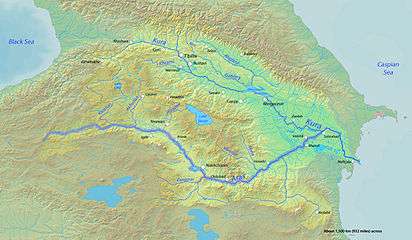Battle of Nakhchivan (1406)
| Battle of Nakhchivan | |||||||
|---|---|---|---|---|---|---|---|
| Part of Timurid Invasion of Azerbaijan | |||||||
 Map of Nakhchivan city near River Aras. | |||||||
| |||||||
| Belligerents | |||||||
|
| Timurid Empire | ||||||
| Commanders and leaders | |||||||
| Abu Nasr Qara Yusuf | Abu Bakr bin Miran Shah | ||||||
The Battle of Nakhchivan was fought between Kara Koyunlu under their Bey, Qara Yusuf and the Timurid Empire under the leadership of Timur's grandson Abu Bakr bin Miran Shah for control of Azerbaijan on October 14, 1406. Qara Yusuf decisively defeated the Timurids in this battle and took over Tabriz the capital of Azerbaijan.
Background
After the defeat of Qara Yusuf in the Battle of Algami Canal in 1402, he escaped to Egypt where he was imprisoned till the death of Timur in 1405. When Timur died in 1405 the Mamluk Sultan Nasir-ad-Din Faraj had released Sultan Ahmed Jalayir and Qara Yusuf. Both while in prison, had agreed that if ever they get out alive, Ahmed would keep Iraq while Qara Yusuf would have Azerbaijan. During this time Azerbaijan was under Umar Mirza bin Miran Shah and Baghdad was under the administration of Abu Bakr bin Miran Shah, the two sons of Miran Shah. The two brothers were rivals and their rivalry allowed for the return of Sultan Ahmed Jalayir who took Baghdad after instigating an uprising from his headquarters at Hillah in late 1405.
The Timurid Civil Wars began in Transoxiana on Timur's death. Khalil Sultan, the son of Miran Shah, was already in Samarkand and declared himself king. Miran Shah wanted to support his son Khalil Sultan and for that purpose, he along with the Abu Bakr bin Miran Shah marched with their forces towards Samarkand. The only opposing force was Shahrukh Mirza in Herat who had marched till Amu Darya but turned back on hearing the news of Khalil Sultan's backup from Azerbaijan.
However, when the Timurid army left for Transoxiana, Tabriz was under Umar Mirza bin Miran Shah. Shah of Shirvan, Ibrahim I and other inhabitants of Azerbaijan region such as Jagirlu Turkmen under Bistam Jagir, ruler of Ardabil; Syed Ahmed Teymuri, ruler of Shaki; Yar Ahmed Qaramanli,the chief of Qaramanli tribe and ruler of Karabakh, rose up against Umar Mirza bin Miran Shah. Ibrahim I wanted all of Azerbaijan for himself. He instigated riots in Ganja and overran Karabakh with the help of his above named allies. Kingdom of Georgia rebelled at the same time, while King George VII of Georgia, according to historian Mirkhond, “sent his ambassadors to express his obedience and subordination to Ibrahim.” Later, in the summer of 1406, in a battle on the Kura River, they routed Umar Mirza bin Miran Shah's army, who quickly abandoned Tabriz on arrival of Shah of Shirvan, Ibrahim I who took the city in May 1406. But in June 1406, Ibrahim I heard of the arrival of Sultan Ahmed Jalayir at the border. He fled back to Shirvan while Sultan Ahmed Jalayir took Tabriz without resistance. Ahmed, however, exacted large amounts of taxes and committed excesses which turned the people against him.
Battle
After Khalil Sultan became king of the Timurid Empire, his brother, Abu Bakr bin Miran Shah returned with his army to Azerbaijan and expelled the forces of Sultan Ahmed Jalayir from Tabriz. However, he met the forces of Kara Koyunlu under Qara Yusuf at Nakhchivan near Aras River on October 14, 1406 who was marching towards Tabriz in order to take the city. The details of the battle have not come down to us but the Timurids were severely defeated and Qara Yusuf carried the day.
Aftermath
Qara Yusuf became a powerful ruler in the region and established his stronghold immediately by making alliances with other Turkmen tribes such as with Bistam Jagir. He occupied Soltaniyeh, Ardabil and Maragheh; and moved the population to Tabriz. This would allow Qara Yusuf to face a counterattack in 1408 by the Timurids who intended on retaking Azerbaijan but would be disappointed.